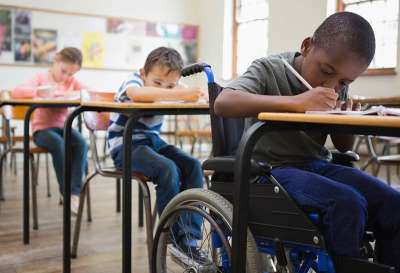Audiotaping
One of the questions most frequently posed by classroom teachers for second grade and up is, “What can I do to keep a child learning in other subject areas if he or she just can't decode or write?” Study guides will not work. One-to-one instruction with a trained professional is not feasible. The most frequent answer to this most frequent question is to use audiotapes.
Intuitively, audiotaping makes sense. If the teacher cannot be available to read aloud to a student, audiotaping offers an alternative. Audiotaping provides students with access to information so that they can continue to learn vocabulary and concepts. Audiotapes of commonly used textbooks are available from the nonprofit organization Recordings for the Blind and Dyslexic for students with visual impairments as well as students with learning disabilities.
Fiction is available from Talking Books, and most public libraries carry book and tape sets. Moreover, commercial audiotaped books are more accessible than in the past and are more socially acceptable in the eyes of the public. If particular books are not available, teachers, parents, volunteers, and other students can tape record reading assignments for the student with reading difficulties to listen to.
What is the adaptation?Audiotapes can be transcripts that students can use to read along with a textbook or trade book. In this way tapes can be an alternative way to present assignments for students who have basic reading skills. An audiotape can also substitute for a textbook; if a student cannot read a text at all, the student can listen to the audiotape instead.
Strategies such as S.O.S. (Survey, Obtain information, Self-test) provide students with a system for active listening to audiotapes through self-questioning. The following are some basic dos and don'ts for effective use of audiotapes as an instructional adaptation:
DO- Contact Recordings for the Blind and Dyslexic or Talking Books considerably in advance of the lesson to order what students may need.
- Enlist the help of students, volunteers, and/or paraprofessionals in recording audiotapes that are not otherwise available.
- Provide guidelines for individuals who make recordings, such as (a) speak in a natural voice and (b) speak at a pace that is considerate to the listener.
- Begin each tape by stating the title of the book or chapter, the author, and the page number at which the recording starts. Provide a consistent system as you develop your library of tapes.
- Provide students with a simple listening guide – particularly if the textbook is too difficult for the student to follow.
- Use audiotapes to record key ideas from mathematics books, particularly math word problems and directions for completing math assignments.
- Construct some audiotapes that paraphrase the textbook or that extract key ideas from the text – particularly if recording or listening time is limited.
- Prerecord tests for students who are unable to read so that they are not dependent on the teacher. During test-taking, the teacher must be free to attend to all students' needs.
- Allow all students access to audiotaped materials for some parts of their instruction, including gifted and talented students who may have advanced assignments (e.g., they can compare an author's reading of a text to their own interpretation).
- Place students who cannot read in an embarrassing situation in the use of audio equipment. Find a quiet place, enlist the help of the special education teacher or parent, or provide a listening buddy. Students will not want to use audiotapes if there is a stigma associated with the process.
- Use audiotapes as a substitute for intensive reading instruction. Audiotapes should be thought of as a temporary tool to convey information, not as a permanent substitute for learning to read.
More articles on Adapting Reading and Math Materials for the Inclusive Classroom.















